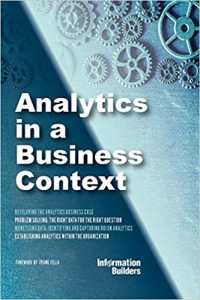
A new book, Analytics in a Business Context, assembled by principal analyst for InsightaaS Michael O’Neil, is the culmination of a series of working group collaborations in the Vision to Value (V2V) best practice community over the past year. A launch party, generously hosted by Information Builders at its Toronto office on February 21, was attended by more than 60 analytics professionals. The event featured a keynote by IB CEO Frank Vella, four presentations by community contributors on each chapter of the book, audience Q&A, and networking time that allowed attendees to meet the book authors and share their own experiences.

Frank Vella, CEO, Information Builders, kicked off the event with some of his insights on analytics. He used the analogy of “data being the new oil” to highlight the potential value of data as a resource for knowledge workers. According to Vella, while access to data presents major opportunities for enterprises, it also creates complexity and poses challenges to be overcome. He quoted a BARC study which found only 17 percent of business intelligence apps that have been purchased are actually being used by knowledge workers.
The goal of analytics, of course, is not only to answer questions but also to empower knowledge workers throughout the organization to do a better job. Vella said four things need to be done well to achieve this goal. The first is to have a plan that lets you know what the results will be and what it takes to get there. Next, the data must be trusted; there is nothing worse than bad data, the effects of which can be magnified over time through use of AI and other advanced analytics. Next, delivery mechanisms are needed to get the right data to its users and, finally, the eventual goal is to embed analytics into business processes and to change corporate culture to support analytics usage.
Vella also pointed to a Canadian customer, York Regional Police, as an example of the successful use of analytics. For York Regional Police, analytics is not about answering questions, it’s about running the business.

The first panel speaker, Dean McKeown, associate director of the Master of Management Analytics program at the Smith School of Business (Queen’s University), started with a look at Developing the Analytics Business Case (Chapter 1 of the book). He said that a key point is knowing what your organization is hoping to achieve, such as assessing the competitive landscape, developing strategies or investing in tools for people to use. Cloud-based analytics can help justify the business case since cloud eliminates much of the infrastructure overhead cost.
McKeown emphasized is that the business case is always about the business and its requirements, not about the tools or the technologies. He also noted that the data needs to be well-understood – it is possible to have too much data, and there is nothing worse than picking the wrong data to use. It is equally important to track lessons learned, using metrics if possible.
Although business intelligence has only been in the spotlight for a few years, artificial intelligence is commanding the attention of operations managers as well as analytics professionals so the business case needs to position the technologies properly. Ultimately, the core question driving the business case is what answers can be extracted from available data, and how do these answers affect how management makes decisions?
McKeown also noted that only about five percent of today’s organizations – the large data-driven organizations such as Google – are exploiting analytics on a broad scale.

Glenda Schmidt, EMBA candidate at the University of Fredericton and former senior business relationship manager, OECM, the second speaker, tackled the topic of Problem Solving: The Right Data for the Right Question (Chapter 2 of the book). An analogy that describes the key question in this chapter is “what comes first, the chicken or the egg?” The answer is that there are a range of factors, including data quality and availability, and the data’s ability to turn up new, unintended issues, that will influence whether the question or the data come first in defining an analytics project. Schmidt also emphasized that analytics is not just an IT problem – it involves all stakeholders and benefits from lots of viewpoints. There is always a concern about data quality and relevance – how can we tell where the data came from (provenance) and how well it is being handled (governance). An important issue remains, however, which is how do we know that we can trust the answers that data analysis yields? This requires involvement from both IT, who can choose the right data to use, and business stakeholders who will know the right questions to ask.
The old adage ‘garbage in, garbage out’ applies in analytics. Care must be taken to avoid biases in the data and to select the best data sets for each question.

Victor Magdic, managing director of Concept Flow, addressed the topic of Monetizing Data: Identifying and Capturing the ROI on Analytics (Chapter 3 of the book). Making money by selling information is certainly not new, although this activity has been more prominent in the media lately due to disclosures from companies who aggregate customer data. The payback from analytics, however, is not always direct monetization – there are other ways to create ROI besides selling data. Magdic used demand-based pricing as one example – the ongoing analysis of demand variations is essential in order that pricing be based on product/service demand. He also noted that processes can only be improved if performance data is analyzed. Another example of savings that may be achieved lies in the use of predictive analysis of everything from truck route design to maintenance schedule optimization. Saving time and resources provides an ROI that helps to justify the investment in analytics.
Magdic also noted some important best practices for monetizing data. For example, start with a solid foundation for building value by using checkpoints and milestones to help measure progress. Another is to focus on the quality of the data. As a final point, he added that it is worth remembering that value can be unlocked from data you already have so the actual costs could be relatively low.

The fourth speaker, Kartik Mathur, senior portfolio manager, Scotiabank, spoke about Establishing Analytics within the Organization (Chapter 4 of the book). Data analytics tools are intended to improve how organizations accomplish tasks, but often there is resistance if users are not able to “trust the system.” Organizations wishing to be data-driven must treat their data strategy as an integral part of an overall business strategy; many are even establishing a chief data officer role to emphasize the importance of data. Many companies are also building Centres of Excellence, i.e., an Enterprise Data Office, to support data analytics and provide expertise to help users to understand the tools and best practices. Data governance is also important for issues such as data ownership – who provides stewardship for data, who is the custodian and who serves as the data privacy officer. The important job of controlling access to sensitive and personal data is another increasingly critical area for management oversight, especially when customer data is involved. In summary, establishing analytics within the organization takes leadership, vision, talent, focus and governance.
After the formal presentations, the panel was joined by moderator Michael O’Neil and Information Builders VP Canada John Ramoutsakis, to answer a series of questions from the audience, which are summarized below.

How do you actually get the insights from the data? Is it ad hoc based on the talent of the people or is there a process? The panel suggested that the basic answer is to empower the users to be inquisitive and to collaborate.
What is the secret to success for anyone getting into business intelligence? The answer to this question was, of course, to read the book! Otherwise, there was no single answer, although credibility, ease of adoption and trust in the data were viewed as critical to success.
What does the future look like for data? The panel agreed that the volume of data being generated will not decrease but there was also a view that data quality, trust and provenance all need to improve. Going forward, it is also likely that many questions and answers inspired by the use of data will become automated through AI and ML, and no longer require human intervention.
The book works through the sequence of business case, plan, hire and ask questions. What work is needed before presenting the business case? And do the users really know how to ask the right questions? The panel felt that cultural change was the best way to prepare for development of the right business case.
How do you really get the ROI? The panel argued that various factors are involved. While people are often afraid to take the first step, there can be a significant cost associated with doing nothing. This approach involves determining what opportunities could be lost if no action is taken. The suggestion was to start small, perhaps with proofs of concept, then grow one step at a time, demonstrating success along the way to build confidence in analytics ROI and productivity benefits.
 Analytics in a Business Context is available on Amazon as a paperback and ebook at the link below!
Analytics in a Business Context is available on Amazon as a paperback and ebook at the link below!








